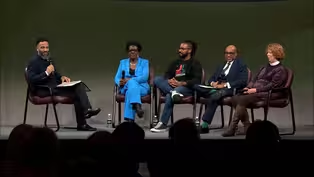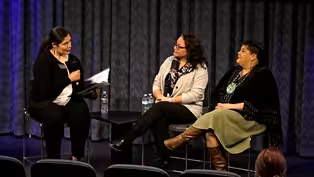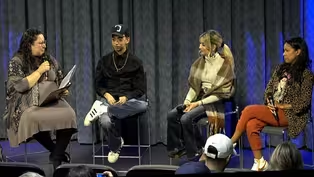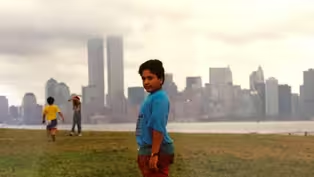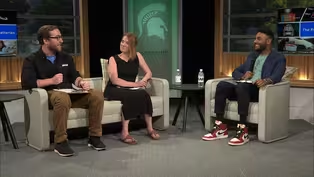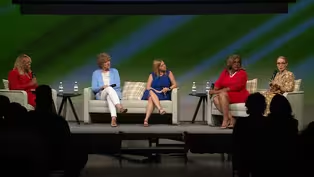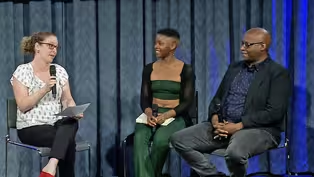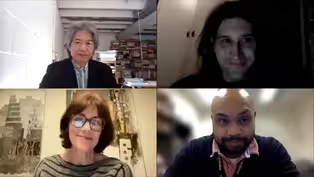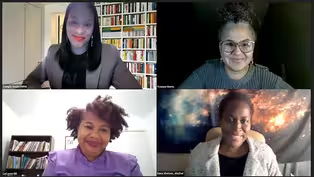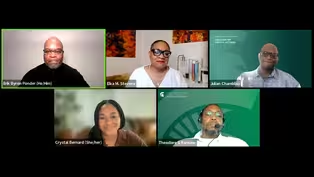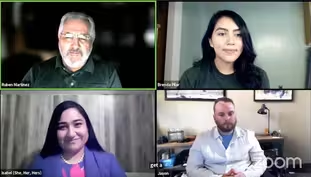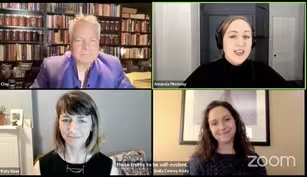
Panel Q & A - Unadopted
Special | 31m 45sVideo has Closed Captions
Panel discussion following the film Unadopted.
Panel discussion following the film Unadopted. Ruben Martinez, MSU Dept. of Sociology, Julian Samora Research Institute, Panel Moderator. Paul Elam, Chief Strategy Officer, MPHI. Kayla Morgan, Business Owner at Resilient Roots Yoga, LLC. Task Force; National Child Traumatic Stress Network.
Problems playing video? | Closed Captioning Feedback
Problems playing video? | Closed Captioning Feedback
WKAR Specials is a local public television program presented by WKAR

Panel Q & A - Unadopted
Special | 31m 45sVideo has Closed Captions
Panel discussion following the film Unadopted. Ruben Martinez, MSU Dept. of Sociology, Julian Samora Research Institute, Panel Moderator. Paul Elam, Chief Strategy Officer, MPHI. Kayla Morgan, Business Owner at Resilient Roots Yoga, LLC. Task Force; National Child Traumatic Stress Network.
Problems playing video? | Closed Captioning Feedback
How to Watch WKAR Specials
WKAR Specials is available to stream on pbs.org and the free PBS App, available on iPhone, Apple TV, Android TV, Android smartphones, Amazon Fire TV, Amazon Fire Tablet, Roku, Samsung Smart TV, and Vizio.
More from This Collection
Panel discussions following WKAR film screenings. Featuring filmmakers, policy makers, community partners and more.
Panel Q & A - The Cost of Inheritance
Video has Closed Captions
Panel discussion following the film The Cost of Inheritance. (30m 59s)
Video has Closed Captions
Panel discussion following the film Warrior Lawyers. (33m 42s)
Panel Q & A – First Voice Generation
Video has Closed Captions
Panel discussion following the film First Voice Generation. (31m 2s)
Video has Closed Captions
Panel following the film "American Jedi." Discussion features the film’s producers. (48m 46s)
Panel Q & A – NOVA Science Studio Showcase
Video has Closed Captions
WKAR showcases highlights from the NOVA Science Studio project. (53m 35s)
Panel Q & A – Building the Reading Brain
Video has Closed Captions
Panel discussion following the WKAR original film, Building the Reading Brain. (36m)
Video has Closed Captions
Panel discussion following the film Afrofantastic. Featuring filmmaker Julian Chambliss (29m 6s)
Panel Q & A – Free Chol Soo Lee
Video has Closed Captions
Panel discussion following the film Free Chol Soo Lee. (29m 48s)
Panel Q & A - Storming Caesars Palace
Video has Closed Captions
Panel discussion following the film Storming Caesars Palace (25m 19s)
Video has Closed Captions
Panel discussion following the episode Afrofuturism, from the Artbound series (33m 56s)
Panel Q&A - Brenda's Story: From Undocumented to Documented
Video has Closed Captions
Panel discussion following the film Brenda's Story (25m 44s)
Panel Q & A - Benjamin Franklin
Video has Closed Captions
Panel discussion following the film Benjamin Franklin. (21m 46s)
Providing Support for PBS.org
Learn Moreabout PBS online sponsorship- Good evening, and welcome.
I'm Ruben Martinez, professor of Sociology at Michigan State University, and I am delighted you could join us tonight for the screening of "Unadopted".
While normally this event would be taking place in person, we're thankful to have this opportunity to connect online and bring you this film followed by discussion with some distinguished panelists.
Before we get started with the discussion, I have a few quick housekeeping notes that I must go through.
Events like this from WKAR are made possible by support from people like you.
Thank you for those of you who have donated to WKAR.
If you're not a WKAR donor yet, you can do so by going to the donate to WKAR link that's on this page, or you can call 517-884-4700.
And again, that number is 517-884-4700.
Tonight's discussion begins with me posting some questions to the panelists.
After that segment concludes, I will put some of your questions to them so that they have an opportunity to respond.
So please enter your questions for our panelists in the comment box.
Now it's my pleasure to introduce our panelists for tonight.
Dr. Paul Elam is chief strategy officer at Michigan Public Health Institute, where he is responsible for diversifying the institute's portfolio to address issues that affect the health and wellbeing of our communities.
He has a doctoral degree from Michigan State University and is nationally recognized for his work on youth violence and prevention, crime and justice, and child maltreatment.
Kayla Morgan is the owner of Resilient Roots Yoga, and a task force member of the National Child Traumatic Stress Network.
She is a certified yoga teacher who herself aged out of foster care, and uses that experience to bring awareness to the over-representation of children of color in the child welfare system.
Both of them are members of the statewide task force in Michigan working to improve the welfare of children.
Welcome to each of you, and thank you for joining us tonight.
I want to start by asking what struck you about the accounts of the youths in the film and their experiences in the foster care system?
Paul, do you want to take that?
- Absolutely.
Thank you, Dr. Martinez.
Appreciate the opportunity to be here with you tonight.
I think what struck me is another story that's consistent with many stories that I've heard over the last decade as we've done this work, that children of color continue to be more likely to experience negative outcomes when they come into contact with our child protection system.
They're more likely to be placed in institutional settings, stay there for longer periods of time, age out of the system without a family, and as a result of these experiences, we see more black and brown children and families who are at a greater risk for negative health, social and economic effects that can last a lifetime, and so it's unfortunate, but that is why we're here trying to bring awareness to this issue, and to support the state in coming up with solutions to change those outcomes.
- Thank you.
Kayla, what struck you?
- As somebody who aged out of foster care, I think I was most impacted by the fact that it was up to the youth to expose the complex of the industry, and to speak up, and again be resilient, after experiencing so much pain, and so much loss, and not really knowing where you come from, and having your culture taken away.
I think that's what struck me the most.
- Thank you.
What is your view on the current rules that exist in the foster care system regarding aging out?
Kayla?
- I don't know too much about the rules.
It seems like the rules change a lot, and apply to different people at different times, but I think what's missing in the child welfare system is a lack of emotional intelligence, a lack of trauma-informed care, a lack of teaching youth about their trauma, and about the way that their brain functions after trauma, and how that they can heal that while practicing resilience, while experiencing grief, and while trying to put all the pieces back together with a really rocky foundation.
- Thank you.
Paul, do you want to add anything to that?
- Yeah, I would say from a policy perspective, the goal is always to try to find permanency for youth who are removed from their families, and unfortunately, the way some youth exit the system results in aging out, and a permanency plan is never developed, or once developed, maybe that plan is not able to be implemented as intended, and so our policy and rules allow for youth to age out, and I think what we're trying to do is ensure that when that happens, that they are fully supported in a way that they can become prosperous and thriving adults.
And we have some examples in our state where we're trying to do that work, but I don't know if you have children, Ruben.
I have five.
I think a lot of our expectations of kids once they turn 19 and 21, we assume that they're adults, but I've got kids who live in my house, if they had to age out and move out when they were 19 or 21, they would be in a lot of trouble.
And so I think we need to rethink that, what are the expectations for kids who age out?
They still need support, many times, and we need to make sure that our kids who are connected with the foster care system also receive that support even if they don't have biological parents to help them.
- Thank you.
Yes, and I have two.
Two children.
They're all grown now, they're both grown.
Kayla, given your lived experience, do you see similarities in your personal foster care story with that of Noel Anaya and the others in the film?
- Yes, I do.
Going back to the scene where one of the girls was getting adopted, and she was deemed adoptable, and I was not.
I was never adopted.
That just really stuck with me, because they all, all of us feel this immense feeling of not being worthy, and not being enough, and not being good enough.
And I think that really translates into high-functioning anxiety and depression, where you're always trying to be the best, or just stay at that surface level, to be enough.
It really hurts your relationships when you're growing.
In foster care, you really only build relationships when you need a place to live.
You don't really get taught to build relationships outside of that.
You have to be your best when you need a place to live, and that really did move, I was taught that, so growing up, aging out, I got into a relationship really quickly for a place to live, and that just spiraled into a lot more trauma that I wasn't prepared for.
- Thank you.
What changes need to be made to improve the situation of older teens in foster care?
Paul?
- That's a great question.
I think the data tell us that the older a child is, the browner a child is, the more mental health issues that they're dealing with, a combination of those things, increases the likelihood that you will not be adopted.
And I think we have to invest more in professional foster care settings that allow us to deal with those factors, when youth are removed and present themselves, and so our conversations with the state right now are focused on how do we get more trained foster care workers who are adept at managing a lot of the traumas that Kayla just mentioned.
It's not these kids' fault that they were removed, or they were exposed to somebody's living situations and experience, sexual assault, physical assault, and now they're trying to cope with that without having access to the profession and skill sets that's needed to help them navigate that, and so oftentimes we have families who want to adopt, and what they do is they want to bring a child in their home that doesn't cause a lot of problems, right?
And once they begin to see these problems, and they're not equipped, then unfortunately they contribute to the ongoing mistrust, because now they're asked to leave their home, and that repeats itself, and so I think we've got a lot to do in terms of the continuum of care that needs to be built, the training that needs to take place, our understanding of when a placement doesn't work, and we continue to move kids, how we create a larger problem than we initially had, because things build up over time.
In the movie, the young men talked about the multiple placements.
And it's unfortunate, but we're beginning to have those conversations, and we need the legislature to support funding for those types of placements so that we can begin to build that capacity within our state.
- Thank you.
So how can we, members of the audience, help these youths?
Kayla, any ideas?
- I think the youth need to find other youth in their same situation, like finding their tribe.
There's enough of us now who have written our stories, like my friend Amnoni Myers, she aged out, and her book is called "You Are the Prize".
And my friend Angela Banks wrote "The Black Foster "Youth Handbook", and there's many, many others who are coming up, and being brave enough to tell their stories, and I think if we could get youth together to share their experiences, and to share their stories of hope and resilience, that that could help youth find that self-determination, and that self-discipline, to keep going.
- Thank you.
Paul, what do you think?
How can the audience members contribute and help these kids?
- You know, I would plus one what Kayla just said.
I think we have to begin to listen to the folks who are most impacted.
Who are at the center of the experience, as we seek to find solutions to the problems that are affecting them, and I'm privileged and honored to have an opportunity to have met Kayla, so that her voice can be included in the work that we're doing with the state-wide task force.
I think our historical policies in the child protection system start with some biased thinking.
Hopefully most of us are engaged in bias training now, unconscious bias training, and we're battling bad practice that I think started back in the 1800s, where we assume that the only way to deal with safety for a child is to remove that child from his or her home.
And we know now that is not totally the truth, that safety can be increased by supporting families, by building upon the assets that exist in families and communities, and not just raising up the deficits.
And we're trying to do our work around that, and a lot of the narrative that we write in case notes, and what youth hear when they go to court, contributes to more trauma, as Kayla just said.
We need to invest more in family and permanency issues, and culture responsive services, and again, foster care placement that are capable of addressing the full spectrum of needs that are presenting themselves, and so I think there's a lot that we can do, and if folks want to learn more about this work, I think we need to educate ourselves on this particular issue.
There's a thing called the browning of the child welfare system, if you look at Casey Family Programs slides, and Annie E. Casey's slides, the kids that are being caught up in this system look a certain way, and it's unfortunate, and we need to deal with that.
So happy to work together with the legislative and executive branch of our government, to make sure resources are there, and we sort of have a commitment to implement solutions at scale throughout our state to help with this issue.
- Thank you.
- And I also think that domestic violence isn't being addressed enough, because like the young man in the video, his mom was being abused, and she needed protection.
And she needed healing, and she needed help, and she wasn't getting that.
She was being shamed and punished for what was happening to her.
And I think a lot of our trauma, and a lot of our youth, are coming from homes with generational domestic violence, to the point it's normal to backhand someone, or to shame someone, and until somebody comes in and says that's not normal, even though that's all you've ever known, then the pattern is just gonna keep going.
- Thank you, that's an excellent point.
Some of the comments by our viewers have to do with the court terms adoptable and unadoptable, and generally adoptable, and specifically adoptable.
Can you speak to that, Kayla?
- Yes, I can.
I guess to me, it just adds onto not belonging, which is a basic human need, to belong, and that adds to not being worthy, and you have a hard enough time trying to figure out your identity as an adolescent.
It's even harder in foster care because you've been taken away from your roots, or your culture, and you really have to figure out who you are on top of all of the shame that comes with being a ward of the state or aging out, or falling into the statistics.
Like me, I hit every single negative statistic that a girl, a brown girl, aging out of foster care would hit.
And I received a lot of shame and a lot of backlash from that, and none of that was ever my fault.
And I think it all goes back to not feeling worthy, and not belonging, and not having a forever home until 32 years old, when I got it myself.
- Thank you.
Paul, do you want to speak to those terms, adoptable and unadoptable?
- Yeah.
I think that's an example of legalese and legal court language that might be insensitive, and one of the solutions we're working on is a new strategy for kinship care.
I think our state has made strides in piloting and expanding kinship care opportunities and placements, but we need more placements to increase access to supportive services, financial supports, and family members.
I think a term like that probably wouldn't even be used if a family member was considering helping out a niece, a nephew, a cousin.
What does unadoptable mean?
And so I think what that means is folks who might be trying to help, and not necessarily have a real relationship with the child, or someone who's in need.
They're sort of assessing what's the risk for me to engage in this situation, and so I think unfortunately that's what we think about as humans.
There's an exchange that takes place.
So I think when we provide mechanisms for family to be the first resort, when safety has been addressed, and I think we can move in a direction where we can minimize the use of terms like that.
So I think of the broad continuum, Ruben, and sort of graduated approaches to find solutions for adoption, and I think we can do better in our state in trying to find uses of kinship and family strategies to help with a statement like that.
- Thank you.
I was looking at some national figures on the number of children or youths that are in foster care and there's statistics on the ages at which they are adopted, and what I saw was that most youth, or the highest proportion, let's say, are adopted between the ages of six months a year, to about two and a half to three years.
So the next question is why won't people adopt teenagers?
Is it because they want younger kids?
Kayla?
- I think yes.
It would be easier.
I mean, I think that's the same reason why people want a puppy and not an adult dog.
We have a voice when we're older.
I went into foster care at 12, between 11 and 12, and I was very angry.
I was very vocal about my anger.
I was very physical about my anger.
And then I was punished for my anger.
I don't, yeah.
And there was no trauma-informed care when I was in foster care, either.
So it was just, I was just labeled delinquent.
Just labeled all of these negative things instead of what happened to me.
- One of the things that came out in the film is Noel talking about how he's expected, and the young lady, I forget her name, they're expected to change to fit the family.
- Yes.
- And is that one of the factors, do you think, that comes into play in terms of people not wanting to adopt teenagers, Paul?
- I can't say it any better than Kayla did.
I think I alluded to it earlier.
Kayla used the term a dog or a pet.
I almost think our thinking around helping in the space is I'm willing to help as long as it's easy for me.
Let me get a one-year-old, a two-year-old, some situation that I can manage, but oftentimes when kids are older, they're dually diagnosed, they got a lot of trauma, a lot of anger, mental health issues, and years of being placed from one setting to another, there are behaviors that come with that.
I think we haven't talked thus far around congregate care settings.
A lot of our youth who end up getting older in the system end up in facilities.
I mean, if you went and visited them yourself, you'd think you were in a detention facility, or jail.
And they're there because of this situation.
And so they'd become institutionalized.
They feel that, they see how they're treated, they see how they're living.
And anybody would know that people have to cope with a life like that.
And so they're not thriving.
What would we expect these kids to actually do?
And so I go back to we really need people who are professionally trained to deal with these types of foster care needs.
A typical family is not going to be able to manage that situation.
In fact, if they try, more than likely they're gonna give up.
And they will add another placement to this kid's life and exacerbate the problem, make it worse.
- Yeah.
I moved every year in the same three months.
Between October, November, and December.
For six years.
And if you know about trauma-informed care, the body keeps the score.
You can have, your body can respond to something traumatic that happened to you a year before on the same day, or years before, on the same day.
And if you don't have people that are trained to deal with that, or to process that with you, they just give up.
It's too hard.
You have everything you need.
Why are you upset?
You don't deserve it.
You're unworthy.
You're ungrateful.
- So when you say you moved in those three months every year for a series of years, were you changing families?
What do you mean by moved?
- Yeah, removed from foster home.
Changing foster home and changing schools.
- Okay.
Thank you.
So another question by one of our viewers is does financial assistance from the state stop when a foster child is adopted?
Paul, you want to take that one?
- Well, I'm not an expert on that.
What I can tell you is depending on the type of case and what's presenting with that case, the support and payment and assistance will vary, depending on circumstances.
So it is a case by case situation.
And so if you present with certain diagnoses, then the case is deemed higher risk, and there's a higher level of compensation.
I think your question might be what does a child actually receive versus, in foster care, versus what they might receive from adoption.
And I can't really speak eloquently to that.
On the foster care side, there is a varying payment amount.
Maybe Kayla can share more about what families receive.
You weren't ever adopted though, right Kayla?
- No, but I know, like you were saying, the risk, the families get more money if I'm a flight risk.
So I've heard me become a flight risk when I wasn't, or it was impossible, because I lived between a wheat field and a corn field.
Or I know that if you get adopted too soon, then you're not eligible for the free college.
- Okay.
So let's talk a little bit about the future of foster care for teenagers.
Are there programs to assist them?
Like, we talked about the development of skill sets, developing resiliency, what's provided to them, and what's our there for them?
- So I remember getting the youth in transition fund, which helped me stock my first apartment, and gave me first month's rent and down payment.
So that was helpful.
And then there was also the Michigan Youth Opportunities Initiative, when I was aging out, which was at the DHS, it was a group of us who had been in foster care, who were given leadership positions on a board, so we could be, we had leadership positions, and they helped us make our resumes, and we did volunteering, we made care packages for kids at Kid First, and blankets for when they got there that they could take with them.
So that was really helpful for me.
That was one of the first things I put on my resume, as work experience, and then there was actually matching, like you got paid to do it, and they matched the funds.
So my first three cars were paid for because of the work I put in that was matched, and I put a down payment on a house when I was 21, because of the match.
So that was helpful.
That stepped in where I guess in a normal household your parents would help you with those type of things.
- Thank you.
Paul?
Do you have anything to add to the support that can be provided to them?
- Yeah, I love those examples that Kayla gave.
I think we have a ton of programs that work.
They've been evaluated.
Philanthropy support and particularly, Annie E. and Casey Family.
I think the problem is we don't have enough of those programs when you think about the capacity and the number of slots that are needed for youth who are aging out.
And then thinking about the duration of time that our youth who age out might need support.
So I think when we think about the longevity of that support, we shouldn't be using a cookie cutter approach for lack of a better term, but more of an approach that's responsive to the needs of the youth.
And so as we look at these programs county to county, and YOI Michigan Youth Opportunity Initiative, or some of the programs to support youth to transition to get their degrees and credentials and institutions of higher learning.
I think those are all wonderful things, and we need to do our best to make sure that all of our youth have access to those types of programs.
- I think also understanding the cross sector between systems, so how closely is the housing system connected to foster care, and how easily and how, like you know the odds.
One in five is gonna experience homelessness.
So making sure that solid foundation and support is there, so I helped build a housing organization called 311 Youth Housing, and what we did was we bought duplexes in the city, and house mentors lived on one side, and youth lived in community with other youth on the other side at a subsidized rent.
And watching those youth, it takes about two and a half years for youth to one, rest.
Then figure out their self-care plan, go through therapy, and then implement what they learned a couple times.
So I think looking at it a different way and really making sure youth have a solid foundation that they can build on is what's gonna help these youth break these cycles of abuse and neglect and trauma.
- So we need to break out of the current system, the paradigm that we have, and find better ways to support these youths and their families, right?
So that is all the time that we have tonight for our discussion.
I want to thank you two, each of you, for sharing your knowledge with us, and joining the conversation, and also for the things that you do to help these youths.
It's very much needed.
And I also want to thank our viewers who joined us tonight.
We hope you enjoyed the presentation and that you will find ways to help foster care youths succeed in life and thrive.
So thank you very much.
Stay safe everyone.
Support for PBS provided by:
WKAR Specials is a local public television program presented by WKAR
